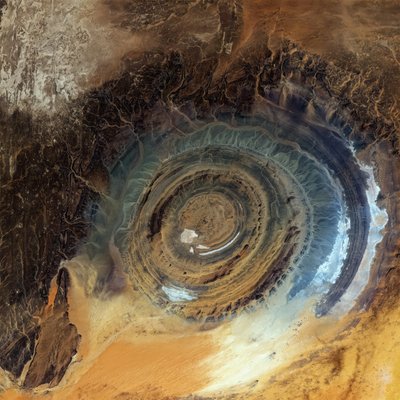Ancient Saharan trading post with 15th-century stone ruins, traditional mosques, and desert architecture. Located near the Richat Structure, a 40km-wide geological formation.
You'll find Ouadane on the southern edge of Mauritania’s Adrar Plateau. Walk through streets lined with sand and the remains of 15th-century mosques, their horseshoe arches still visible. Drive 40 kilometers northeast to see the Richat Structure, a circular geological formation 40 kilometers wide that astronauts spot from space. Centuries ago, caravans carrying salt and gold passed through the old town, leaving behind empty stone houses and handwritten texts that show its role in trade and education. Today, a small community lives outside the ancient walls, adapting to the dry desert conditions.
The Richat Structure: A Circular Geological Formation
The Richat Structure rises 40 kilometers northeast of Ouadane. Its rings of eroded rock layers, formed over 500 million years, create a distinct circular pattern. Early researchers thought a meteorite caused it, but studies now show it formed from magma pushing upward and gradual erosion. Stone tools found here, some over a million years old, indicate early humans once lived in the area. You can reach the site by 4x4, crossing rocky ground where the full size of the formation becomes clear only when you stand beside it.
Walking Through the Old Town’s Ruins
Ouadane’s abandoned medieval quarter, recognized by UNESCO, served as a key stop for caravans starting in the 1100s. Stone houses with central courtyards line narrow paths that slope downward from Tegherbeyat, the oldest part of the town. Look for patches of dried clay on walls and the base of a 15th-century mosque, where five rows of arches once held up a terrace. A path called “rue de 40 Savants” connects two historic mosques, cutting through the middle of the ruins. Goats and small mammals now wander among the crumbling walls, which slowly disappear under shifting sand.
Mosques and Manuscripts: Evidence of Learning
The Old Mosque, built in the 15th century at the town’s base, and the New Mosque, constructed two centuries later on higher ground, highlight Ouadane’s religious and academic past. The Old Mosque’s 24-meter eastern wall marks where traders once prayed together. Though its minaret is missing, sections of the walls still stand. Families in Ouadane keep around 3,000 handwritten texts in private collections, including early copies of the Quran and studies on stars and legal systems. These documents emphasize the town’s importance as a place of learning during the medieval period.
The Museum of Ouadane: Understanding Desert Life
Located in the modern part of town, the Museum of Ouadane presents objects from the time when caravans crossed the Sahara. See slabs of salt mined in Idjil, metal jewelry, and navigation tools used by caravan leaders. Information panels describe how the town’s design—tightly packed houses around a central mosque—helped people survive in the desert. The museum also discusses how spreading deserts affect both ancient ruins and current settlements. After your visit, head to the new town’s main square to watch locals play bocce and sip mint tea under acacia trees.
Getting There and Staying Safe
A 4x4 vehicle is essential to reach Ouadane, usually booked through tour companies in Nouakchott or Chinguetti. The 93-kilometer trip from Chinguetti takes two hours on unpaved desert roads. Hotel Vasque provides simple rooms and local dishes like millet porridge. Though security has improved, barbed wire around some buildings reminds visitors to stay cautious. Plan your trip between November and February for cooler weather, and bring plenty of water—humidity stays below 20% most days. Many guided tours to the Richat Structure also visit oases such as Tanouchert, where date palms offer shade.






